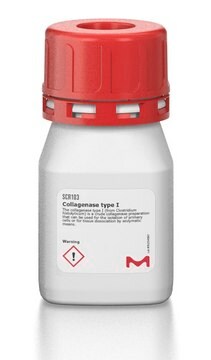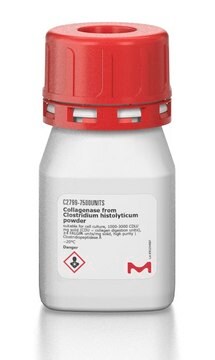C5894
Collagenasi
non-sterile; 0.2 μm filtered, Type IA-S, 0.5-5.0 FALGPA units/mg solid, ≥125 CDU/mg solid
Sinonimo/i:
Clostridiopeptidasi A
About This Item
Prodotti consigliati
Livello qualitativo
Sterilità
non-sterile; 0.2 μm filtered
Stato
lyophilized powder
Attività specifica
≥125 CDU/mg solid
0.5-5.0 FALGPA units/mg solid
PM
68-130 kDa
Temperatura di conservazione
−20°C
Cerchi prodotti simili? Visita Guida al confronto tra prodotti
Applicazioni
Azioni biochim/fisiol
Avvertenza
Definizione di unità
Nota sulla preparazione
Substrato
Avvertenze
Danger
Indicazioni di pericolo
Consigli di prudenza
Classi di pericolo
Eye Irrit. 2 - Resp. Sens. 1 - Skin Irrit. 2 - STOT SE 3
Organi bersaglio
Respiratory system
Codice della classe di stoccaggio
11 - Combustible Solids
Classe di pericolosità dell'acqua (WGK)
WGK 1
Punto d’infiammabilità (°F)
Not applicable
Punto d’infiammabilità (°C)
Not applicable
Dispositivi di protezione individuale
dust mask type N95 (US), Eyeshields, Faceshields, Gloves
Scegli una delle versioni più recenti:
Possiedi già questo prodotto?
I documenti relativi ai prodotti acquistati recentemente sono disponibili nell’Archivio dei documenti.
I clienti hanno visto anche
Protocolli
This procedure may be used for Collagenase products.
Il team dei nostri ricercatori vanta grande esperienza in tutte le aree della ricerca quali Life Science, scienza dei materiali, sintesi chimica, cromatografia, discipline analitiche, ecc..
Contatta l'Assistenza Tecnica.









